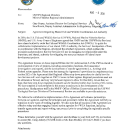U.S. Fish and Wildlife Service (Service) biologists work closely with the U.S. Army Corps of Engineers, the Bureau of Reclamation, and state agencies to help develop federal water resource projects (e.g., dams, harbor development, flood control, and water storage projects) that meet the critical needs of local communities and conserve fish and wildlife. Under the Fish and Wildlife Coordination Act (FWCA), Endangered Species Act, Clean Water Act, and National Environmental Policy Act, the Service works with the Corps of Engineers to conserve fish and wildlife and their habitats during water resource development. These authorities ensure that adverse impacts are addressed and opportunities to help recover imperiled species are seized early in federal project planning by all involved stakeholders.
The FWCA provides the basic authority for the Service's involvement in evaluating impacts to fish and wildlife from proposed water resource development projects. It requires that fish and wildlife resources receive equal consideration to other project features. It also requires federal agencies that construct, license, or permit water resource development projects to consult with the Service (and the National Marine Fisheries Service in some instances) and state fish and wildlife agencies regarding anticipated impacts on fish and wildlife and measures to mitigate these impacts. A more complete discussion of the FWCA and the Service's role in conservation partnerships is found in the Service's Fish and Wildlife Coordination Act Handbook. This document is meant to serve as a guide for Service biologists, as well as government and non-government partners working together to advance positive water projects and conserve fish and wildlife resources.
In planning Civil Works projects, the Corps of Engineers utilizes their “SMART” planning process that is intended to improve and streamline feasibility studies and reduce costs by focusing on early engagement by all stakeholders and using a risk-based alternative evaluation process. A 2015 handbook, SMART Planning Feasibility Studies: A Guide to Coordination and Engagement with the Services, demonstrates how key environmental coordination and compliance activities fit into that process and emphasizes early engagement and coordination with the Service and the National Marine Fisheries Service at all stages of a planning study.
Corps of Engineers Civil Works projects are authorized by legislation including Water Resources Development Acts (WRDA). WRDA legislation provides the Corps of Engineers with the authority to study water resource problems, construct projects, and make major modifications to projects. WRDA bills also contain general provisions as well as special study authorizations.
The provisions and contents of WRDA legislation are cumulative and new legislation does not supersede or replace previous legislation. New WRDA add to the original language contents and often amend provisions of previous acts. Current WRDA legislation is available in the U.S. Code.





